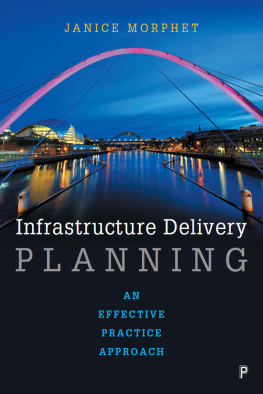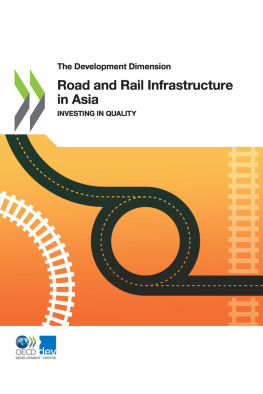
Best Practice in
Infrastructure
Asset Management
Creating and maintaining value for all stakeholders
Edited by Jeffrey Altmann, First State Investments

 Published in December 2010 by
Published in December 2010 by
PEI Media Ltd
Second Floor
Sycamore House
Sycamore Street
London EC1Y 0SG
United Kingdom
Telephone: +44 (0)20 7566 5444
www.peimedia.com
2010 PEI Media Ltd
ISBN 978-1-904-696-82-7
eISBN 978-1-908-783-56-1
This publication is not included in the CLA Licence so you must not copy any portion of it without the permission of the publisher.
All rights reserved. No parts of this publication may be reproduced, stored in a retrieval system or transmitted in any form or by any means including electronic, mechanical, photocopy, recording or otherwise, without written permission of the publisher.
The views and opinions expressed in the book are solely those of the authors and need not reflect those of their employing institutions.
Although every reasonable effort has been made to ensure the accuracy of this publication, the publisher accepts no responsibility for any errors or omissions within this publication or for any expense or other loss alleged to have arisen in any way in connection with a readers use of this publication.
PEI Media editor: Anthony OConnor
Production editor: William Walshe
Cover design: Joshua Chong
Printed in the UK by: Hobbs the Printers (www.hobbs.uk.com)
Cover image: Courtesy of iStockphoto
Figure and tables
Introduction
By Jeffrey Altmann, First State Investments
The ability to create enhanced operational performance in the infrastructure industry through stakeholder management, herein defined as asset management, is now widely acknowledged by both limited partners (LPs) and general partners (GPs) as a necessity in creating alpha (that is, a source of value uncorrelated to market movements by gaining additional returns without additional risk) as well as reducing risk. In addition, regulators, consumers and other stakeholders increasingly require greater accountability from owners of infrastructure assets in creating more efficient, reliable and competitive pricing of services during this time of austerity. This book provides active stakeholders in infrastructure with comprehensive understanding of what constitutes best practice in analysing, acquiring and managing infrastructure assets from an asset management perspective.
As infrastructure develops into an asset class in its own right, asset management is also developing into its own management discipline. Unlike portfolio management, which requires skills in assessing financial performance and how various assets will behave or correlate under various scenarios, effective asset management requires skills in finance, operations, project management, government, privatisation, regulation and corporate development. It also require strong, traditional board skills including setting strategy, key management appointments and succession planning, risk oversight and governance. Asset managers are proactively engaged with respective portfolio companies throughout their investment cycle, using their industry expertise to work with the management of the respective portfolio companies to maximise value creation and minimise downside risk.
Until recently there was a heavy predominance of infrastructure funds solely relying on value creation generated by very highly geared financial and fee structures, along with the notion of letting the assets run themselves with reduced capital investment. The global financial crisis has abruptly brought this approach to an end for the foreseeable future. New requirements of needing a club of banks to provide debt financing, more stringent industry gearing ratios as well as tighter debt covenants mean GPs now have to focus on creating value through enhanced operational performance.
Asset management has always been an underlying discipline within the infrastructure industry. The key issue has been under what ownership (public or private) and regulation (or no regulation) these assets have been managed. Under government ownership the focus is on public service, whereby the provision of services is provided to all. These services have been historically cost-inefficient as the respective owners (that is, governments) were not focused on profitability, but rather on attempting to provide quality services at a price that was essentially subsidised by all taxpayers. Consequently, large corporate overheads were developed and infrastructure assets were typically over-engineered and gold-plated.
Under private ownership, conversely, the key differentiating focus is on profitability and high quality of service, which is contingent on the type of regulation (such as cost-plus regulation or incentive-based regulation) applicable to the asset. It should be noted that private owners will implement their respective differentiated incentives to create short-term and/or medium-term and/or long-term value depending on their respective investor base (such as publicly traded strategic players, private equity funds and unlisted infrastructure funds).
The global financial crisis has recently created a mutual focus, for both publicly and privately held infrastructure companies. Asset management is now a requirement for all infrastructure owners to create enhanced operational efficiencies that can no longer rely on government subsidies or highly geared financial structures.
There is a great misnomer among some observers outside of the infrastructure industry that the asset class is boring and changes are very slow to implement. However, considering the confluence of privatisations, technological changes, regulatory changes and growth of emerging markets over the last 15 years, it has become evident that this period has been the most dynamic since many countries spent years rebuilding their infrastructures out of the ruins of the Second World War. Nevertheless, recent events, including the fallout from the global financial crisis, indicate that the next two decades at least could be even more dynamic. Various factors, both regionally and globally, could put various pressures on infrastructure companies, which could have the potential to positively or negatively impact these entities. These factors include those outlined below.
Enormous build-out requirements
Booze Allen Hamiltons report entitled Lights! Water!Motion! estimated in February 2007 that the global build-out requirements for the next 25 years would equate to some $40 trillion, while the OECDs Infrastructure to 2030 report, published in January 2008, estimated it could be high as $65 trillion. The numbers are extremely large and investment will be required from both public and private sectors around the globe.
Many OECD countries now have large refurbishment requirements to replace their existing infrastructures that were built directly after the Second World War. In emerging markets, particularly China and India, there is an enormous need to provide appropriate infrastructure for these fast-growing economies. Paradoxically, while many governments view these infrastructure build-outs as an opportunity to create jobs, other governments are postponing projects indefinitely due to financial constraints and concerns over large cost overruns. Herein lies one of the greatest opportunities for institutional and private infrastructure investors: to work with both publicly and privately held owners that require capital.
Next page












 Published in December 2010 by
Published in December 2010 by